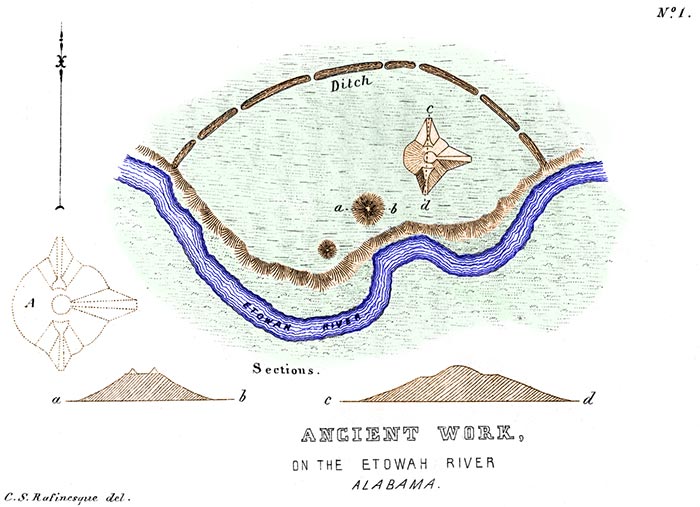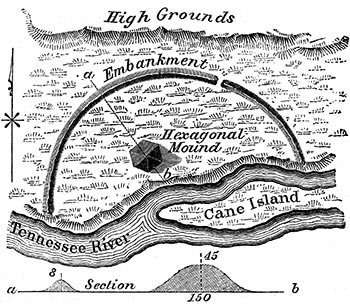PLATE XXXVIII. No. I.75
ANCIENT WORKS ON THE ETOWAH RIVER, ALABAMA.

This work occurs within the present limits of the State of Alabama, upon the banks of Etowah river, a branch of the Coosa. It is situated upon an alluvial "bottom," at an angle or bend of the stream; and its defences consist of a semi-circular ditch, the flanks of which rest on the river. This ditch is twenty-five or thirty feet in width, by eight feet in depth; and is interrupted by no less than seven passage-ways, placed at irregular intervals, and formed by leaving the earth unexcavated at the points where they occur. It is a remarkable fact that no embankment accompanies the ditch; although the work is not entirely singular in that respect. Within the enclosure thus formed by the river on the one hand and the ditch on the other, are several mounds, one of which is of great size and extraordinary character. It measures upwards of seventy-five feet in height, and is twelve hundred feet in circumference at its base. It is truncated, the area at its summit having a diameter of one hundred and forty feet. A graded avenue, which may be ascended on horseback, leads to its top from the east. Upon its northern and southern sides, at the height of forty feet, are triangular platforms or terraces, which are also reached by graded ascents from the plain. The supplementary plan A exhibits the outlines of the monument. Upon its top, trees are growing, which, at the height of a man's head from the ground, measure little under eleven feet in circumference. A fallen oak measured by Mr. Cornelius in 1818 was found to be, at the distance of six feet from the branching of the roots, twelve feet four inches in circumference, exclusive of the bark. There are two other truncated mounds, to the south-west of the great mound, but of less dimensions. One of these has a perpendicular altitude of thirty feet; and its summit was fortified, with a parapet and palisades, by the Cherokees in their war with the Creeks. The earth taken from the ditch above mentioned was probably used in the construction of these mounds.
 An analogous work of some interest,
(Fig. 21,) but partially destroyed by the
Tennessee river, upon the bank of which
it stands, occurs near the town of Florence, in Alabama. "It consists of a
large mound, hexagonal in form, truncated, and forty-five feet in height by four
hundred and forty feet in circumference
at the base. The level area at the
summit is one hundred and fifty feet
in circumference. It appears to be
composed of the ordinary surface loam,
and is carried up with great regularity.
So far as it has yet been examined, no
traces of bones or other foreign substances have been discovered.
An analogous work of some interest,
(Fig. 21,) but partially destroyed by the
Tennessee river, upon the bank of which
it stands, occurs near the town of Florence, in Alabama. "It consists of a
large mound, hexagonal in form, truncated, and forty-five feet in height by four
hundred and forty feet in circumference
at the base. The level area at the
summit is one hundred and fifty feet
in circumference. It appears to be
composed of the ordinary surface loam,
and is carried up with great regularity.
So far as it has yet been examined, no
traces of bones or other foreign substances have been discovered.
"Partly surrounding the mound is a wall two hundred and seventy feet distant from its base, which extends from the main river below, to a branch formed by Cane island above, constituting a segment of a circle, the centre of which would be in the Tennessee river. The wall is about forty feet across the top, and, making allowances for the ravages of time, must have been originally from twelve to fifteen feet high; it is now about eight feet in height. The mound and wall bear the same marks of antiquity, both being covered with large timber of the same age and description with that found growing on the surrounding lands. The wall has what appears to be a ditch on the outside.
"These works are situated on the river bottom, and are half surrounded by a very high ridge, which runs parallel to the Tennessee river, about four hundred yards distant. This ridge, upon which the principal part of the town of Florence is situated, overlooks and entirely commands the whole. The mound, with its surrounding wall, thus situated and exposed to attack, could hardly have been designed as a place of defence. It must have been appropriated to another purpose."76
75. From the Rafinesque MSS. The scale on which the plan is drawn is not given. It is probably about five hundred feet to the inch. An account of this work, substantially the same with that given by Prof. Rafinesque, was published by Mr. E. CORNELIUS, in Silliman's Journal, vol. i. p. 223. Mr. Cornelius was accompanied in his visit by several Indian chiefs, who, he says, "gazed upon the remains with as much curiosity as any white man. I inquired," continues Mr. C, "of the oldest chief, if the natives had any tradition concerning them; to which he answered in the negative. I then requested each to say what he supposed was their origin. Neither could tell; but all agreed in saying. 'They were never put up by our people.'"
76. Western Messenger.

